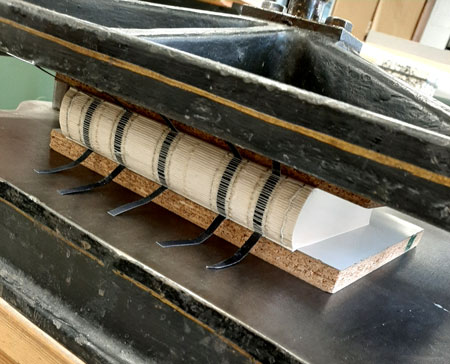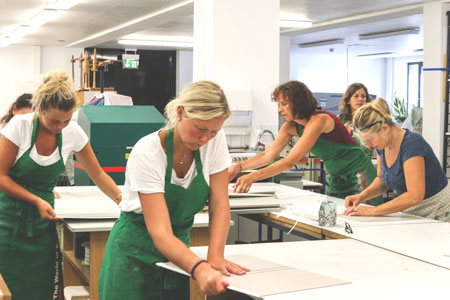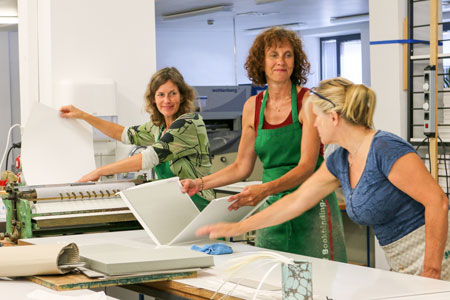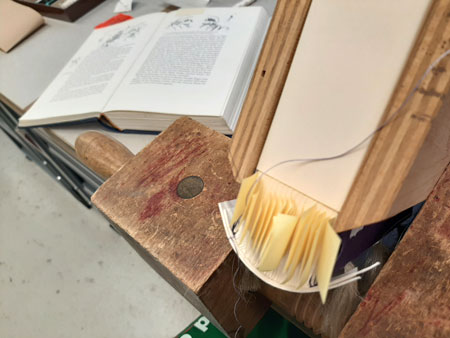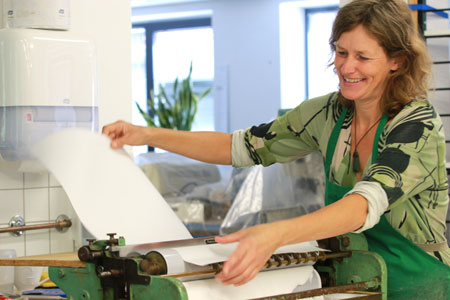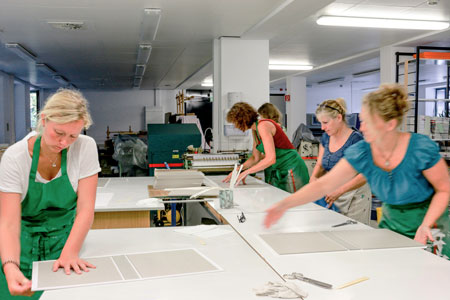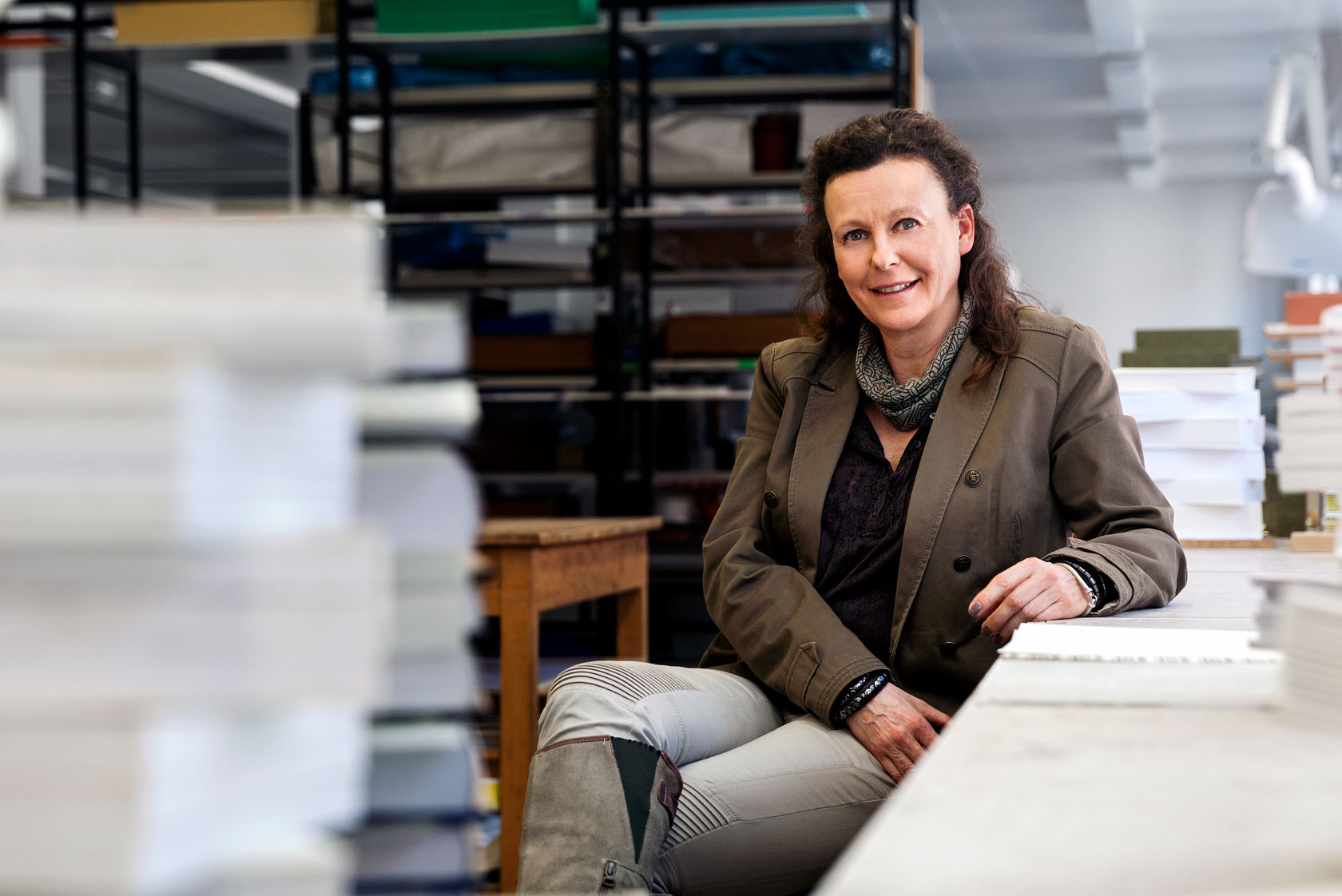
Behind the Scenes: UNESCO Declares Bookbinding as Intangible Cultural Heritage
Many people know about UNESCO's Cultural and Natural Heritage from travelling. Few, however, know that Intangible Cultural Heritage also exists. Recently, the craft of bookbinding has also been recognised in the nationwide Intangible Cultural Heritage Register. In this article, we reveal how this came about, how something becomes a UNESCO Heritage Site and what ZBW employee Elke Schnee has to do with it.
by Claudia Sittner

What is „Intangible Cultural Heritage“?
The United Nations Educational, Scientific, Cultural and Communication Organization (UNESCO) defines this as “oral traditions, performing arts, social practices, rituals, festive events, knowledge and practices concerning nature and the universe or the knowledge and skills to produce traditional crafts”, according to the Website of the UNESCO about Intangible Cultural Heritage. Traditional crafts are also eligible. Examples of Intangible Cultural Heritage are German bread culture, Hessian „Kratzputz“ (an artistic, decorative plastering technique), fairy tale telling or East Frisian tea culture.
Elke Schnee, sign language and bookbinding at the ZBW
To explain what ZBW employee Elke Schnee has to do with UNESCO, you have to backtrack a bit. 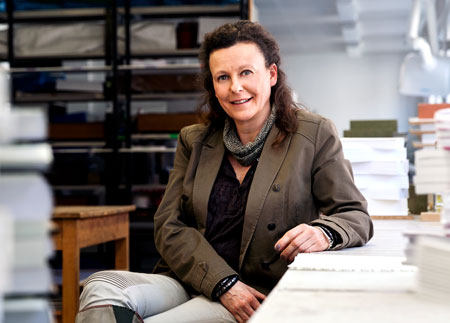 Schnee has been working in the bookbindery of the ZBW – Leibniz Information Centre for Economics for almost exactly 40 years. She did her apprenticeship there in the 1980s, and a little later her master’s degree (German „Meister“), before taking over the management of the then rather large bookbindery a short time later.
Schnee has been working in the bookbindery of the ZBW – Leibniz Information Centre for Economics for almost exactly 40 years. She did her apprenticeship there in the 1980s, and a little later her master’s degree (German „Meister“), before taking over the management of the then rather large bookbindery a short time later.
There were two deaf trainees there who were henceforth under her care. Out of the situation, she took the trainer aptitude test and learned sign language for four years. Above all, however, she learned sign language in practice, in conversations with colleagues and trainees, says Schnee. “I fell in love with sign language on my first day at the ZBW.

Sign language: for Elke Schnee it was a matter of course to learn them
There were already two deaf people there, and I was fascinated by how they talked to each other. Then I learned several signs right away”, reports the master bookbinder. In the video interview, she remembers exactly her first four words: book, coffee, milk and end of work (the German „Feierabend“). It has always been important for her to integrate all employees and trainees. Everyone should be heard and understood.
- Cooperation in the bookbindery of the ZBW
Over the years, she has shown 33 trainees how the ancient craft of bookbinding works in all its facets. Of these, 18 percent were deaf. Today, the bookbindery of the ZBW no longer trains, and it is not alone in this: while 150 people were still trained as bookbinders nationwide in 2019, there were only 60 left in 2020. “We have to stick and work together now, otherwise the centuries-old knowledge will gradually be lost”, Schnee appeals.
The BDBI and the UNESCO
It was not only this decline that prompted the Association of German Bookbinders (BDBI), in which Elke Schnee has been active for several years, to apply for a very special award: the inclusion in UNESCO’s Intangible Cultural Heritage List. “Before we are declared a dying species, this seemed like a good measure”, Schnee explains. The BDBI members felt encouraged to do so because they often heard of similar crafts, such as organ craftsmanship, being included. UNESCO’s text about tradtional craftmanship worthy of protection quickly confirmed that the craft of bookbinding was suitable for application.
Background UNESCO in Germany
UNESCO first initiated the designation as Intangible Cultural Heritage in 2003. Under the motto “Knowledge.Skills.Passing on”, around 580 crafts and traditions from 130 countries have since been included in the international list. There are also national inventories. Germany joined the UNESCO Convention for the Safeguarding of the Intangible Cultural Heritage in 2013. There are currently 131 entries on the national list including organ craftsmanship (Orgelbau), biike burning (an annual bonfire night celebration – Biikebrennen) and blue printing (a dyeing process for linen or cotton fabrics – Blaudruck).
Each German federal state may submit four proposals per year to the Secretariat of the Standing Conference of the Ministers of Education and Cultural Affairs. If the proposals are approved there, the maximum of 64 proposals will be passed on to the Expert Committee on Intangible Cultural Heritage of the German UNESCO Commission. After a thorough examination, the Committee makes recommendations and forwards them to the Standing Conference of the Ministers of Education and Cultural Affairs and to the German Government Commissioner for Culture and the Media for confirmation. Only after this multi-stage procedure is the Intangible Cultural Heritage entered in the Federal Register. Gold and jewels do not qualify for this status. Why does one take on the effort anyway?
The application as Intangible Cultural Heritage
Back to Elke Schnee: She has been a member of the BDBI board since 2019, first as a guest member, since 2021 officially elected. And in this capacity, she has slipped into the very working group that dealt with the application for inclusion in the UNESCO list.
One morning, Schnee was sitting unsuspectingly in her first BDBI board meeting when she was told that two letters of recommendation had to be organised as quickly as possible. She then quickly found two supporters in the former Kiel Mayor Susanne Gaschke and the ZBW Director Klaus Tochtermann. Once this hurdle was cleared, the professional association submitted its application to the Ministry of Culture and Science of North Rhine-Westphalia (NRW), the BDBI’s home state, in November 2019.
Waiting for UNESCO
In the meantime, the association learned that it had cleared a first hurdle on the way to becoming an Intangible Cultural Heritage Site: its proposal had made it into the top 4 of NRW. Almost 1.5 years after the application, in the middle of the Corona pandemic in spring 2021, the good news came: the craft of bookbinding had made it onto the German UNESCO’s list of Intangible Cultural Heritage. The celebration was small due to the corona pandemic, a certificate was presented and the BDBI members were allowed to use the corresponding UNESCO logo from then on. “The craft of bookbinding has an important function for cultural heritage and the culture of remembrance”, it says in the current Nationwide Inventory of Intangible Cultural Heritage. And further: “Despite digitalisation, the craft of bookbinding has not lost its vitality. It contributes in particular to the preservation of old books and archival materials. Interested laypeople have the opportunity to attend courses at adult education centres or in private workshops and thus learn the basics of bookbinding.”
UNESCO Cultural Heritage, and now?
When asked what this award means to her personally, Elke Schnee says: “Of course it’s nice to know: It’s a profession that I’m not the only one who thinks it’s great, it has such a charm that many people think it’s good. But apart from that, for me it’s more like: OK, we’ve already come this far, we’re already so few that we get species protection.“
Elke Schnee was pleased, however, because at the same time as the craft of bookbinding, German sign language also made it onto the German UNESCO’s List of Intangible Cultural Heritage.
To all those who are also thinking about applying, she recommends: “Just do it! You can only win.” It is important to keep an eye on the deadlines, to get help and more people on board, and to proceed in a parallel and structured manner. The checklist (German) on the German UNESCO website would help.
Bookbinding soon to be a World Cultural Heritage?
Once a year, the Intergovernmental Committee for UNESCO inscribes new Intangible Cultural forms and good practice examples of the preservation of the Intangible Cultural Heritage of Humanity on the international UNESCO lists. So far, Germany has been involved with five entries. The following have been inscribed:
- idea and practice of organising shared interests in cooperatives,
- blue printing,
- craft techniques and customary practices of cathedral workshops, or Bauhütten,
- falconry,
- organ craftsmanship and organ music.
And perhaps one day the craft of bookbinding will also find its way into this international list, especially since bookbinding exists in almost every country in the world. This will not prevent the shrinking of this profession in times of digitalisation, but at least it will create good conditions to make people aware that it is worth protecting and preserving.
And Elke Schnee?
She is thinking about a book about the craft of bookbinding, so that the centuries-old knowledge about books will really not get lost. Abolishing books and the craft of bookbinding is out of the question for her: “If people only work digitally, they will have to go to occupational therapy later on, where they will learn basket weaving and bookbinding. Simply to keep them healthy.”
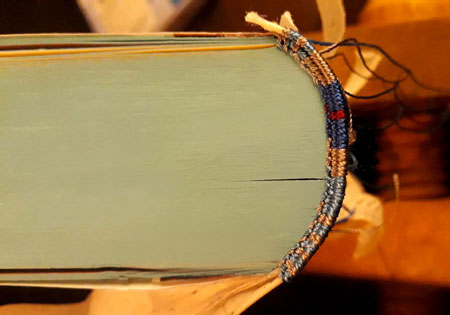
And a little later: “It fills me with happiness when I see my work in the evening after a day in the workshop. I had such a day yesterday. It felt so good to see what I had done – I picked up the book again and thought: that was a good day.”
This text has been translated from German.
This might also interest you:
- German Nationwide Inventory of Intangible Cultural Heritage
- Become a UNESCO Intangible Cultural Heritage (German)
- My World is … bound (German)
- The love of the craft – Elke Schnee – bookbinder (German)
- Elke Schnee receives the Badge of Honour of the State of Schleswig-Holstein
Claudia Sittner studied journalism and languages in Hamburg and London. She was a long time lecturer at the ZBW publication Wirtschaftsdienst – a journal for economic policy, and was the managing editor of the blog ZBW MediaTalk. She is also a freelance travel blogger (German), speaker and author. She can also be found on LinkedIn, Twitter and Xing.
Portrait: Claudia Sittner©
Photos: ZBW©, photographers: Sven Wied, ZBW
View Comments

Best Practice at the ZHB Lucerne: Agile Working in the Context of Small and Large Libraries
In a world which is moving continually faster, it’s essential for time-honoured...

